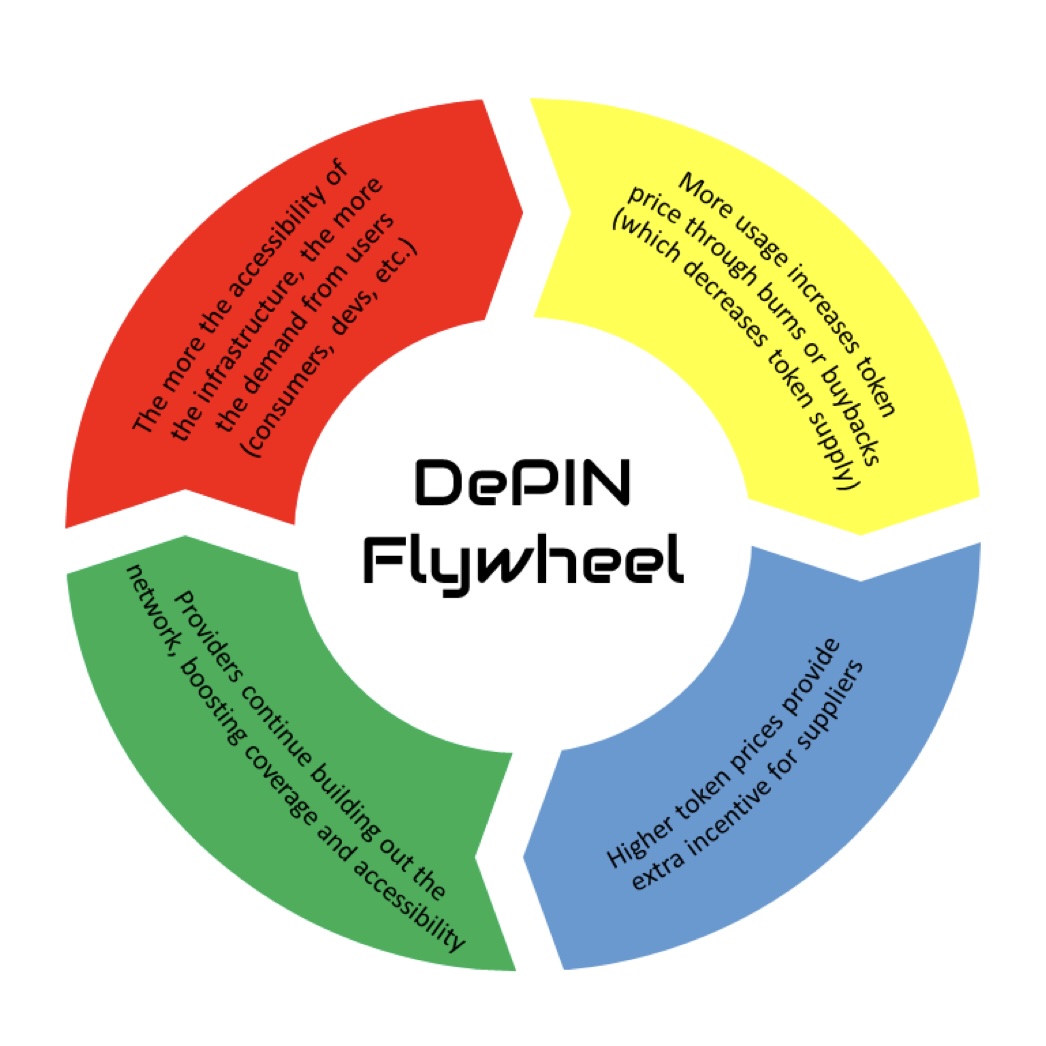
DePIN Could Be the Next Trillion-Dollar Sector – Here’s What You Need To Know
HodlX Guest Post Submit Your Post
What is DePIN
There’s been a lot of buzz lately about DePINs (decentralized physical infrastructure networks).
This sector is attracting a lot of attention because it has a massive potential user base and a unique way to expand infrastructure networks from the ground up without needing a central authority.
As a report by Messari suggests, DePIN could add $10 trillion to the global GDP (gross domestic product) in the next decade and $100 trillion the decade after.
DePINs are seen by some as a game-changer for how we distribute resources around the world not just physical things but digital ones too.
They also hold promise as a brand new way to build large-scale infrastructure projects.
Put simply, DePINs are the decentralized version of traditional infrastructure and services we humans use.
At the heart of each of these projects, there is an economy that guarantee the liveliness of its offerings.
This happens by incentivizing network participants i.e. providers to allocate their capital or unused resources like storage space.
We consider a project in the DePIN sector if it is a blockchain-based platform that incentivizes people to join a network and maintain physical hardware or software services.
Such services span across a vast landscape, including but not limited to IoT (internet of things) sensors, storage, weather stations, Wi-Fi, computational power, energy grids, mapping (navigation) and even food delivery.
The ultimate goal here is to create a distributed and transparent system, boosting the scalability and efficiency of today’s infrastructures.
These infrastructures are available in two major categories.
- Hardware-focused or PRNs (physical resource networks) These resources are tied to a specific location. They provide services in a particular area and often can’t be easily moved elsewhere. Wireless, energy, and sensors (e.g. weather, mapping, noise pollution) networks all belong to this branch.
- Software-focused or DRNs (digital resource networks) like computing power, storage, retrieval, data / AI (e.g., wholesale data) and services marketplaces (e.g., talents, ride-sharing, food delivery, ad networks), that are all location-independent and fungible.
How does DePIN benefit us with real world advantages
Historically speaking, building a physical infrastructure has always demanded a huge amount of capital and operational expenses, making this industry dominated by big tech companies like Amazon and Microsoft.
Now DePIN is here to disturb the monopoly by leveraging blockchain technology.
Decentralizing of physical systems has notable benefits over the centralized approach, such as the following.
- Higher level of security no single point of failure
- Transparency
- Cost efficiency
- Scalability
- Financial rewards for network contributors
How does a DePIN project actually work
DePIN bridges between real-world infrastructure and the blockchain. Imagine it like this there’s a physical equipment/resource owned by a provider.
Then a special software acts as a middleman, connecting this equipment/resource to the blockchain. Finally, a public ledger like a giant logbook keeps track of everything.
Let’s dive deeper into the three components mentioned above.
Physical equipment / resource
DePINs rely on physical infrastructure to be constructed and developed in the real world.
This infrastructure can be various things, like sensors, cars, storage hardwares or even solar panels, typically managed by individual / private providers.
Middleware
This part acts like a translator between the blockchain and the physical world. It uses a special system, like an oracle, to bring in real-world data.
This data is then examined to figure out how much users are contributing and the actual need for the service.
Blockchain architecture
DePINs utilize blockchain technology’s capabilities. Blockchains function as tamper-proof registries and ledgers, making them ideal for tracking devices and also establishing token-based digital economies.
The blockchain plays three important roles in DePINs i.e., administration, payments and record-keeping which are discussed below.
- Administration DePINs build permissionless systems based on blockchain technology, meaning that anyone can become a user or a provider if they have essential resources / equipment.
- Payments Users pay for services through blockchain-based systems, while providers get rewarded for their contributions.
- Record-keeping Every single activity and transaction in the network is recorded on the blockchain, which is often available for public viewing.
Last but not least, DePIN networks have a magic wand that helps them overcome the difficulties with building a sustainable, functional and truly decentralized physical infrastructure in the real world.
That secret superpower is called, ‘The DePIN Flywheel.’ The key to a successful DePIN project is a self-sustaining loop of growth.
Tokens act as rewards to attract people to join the network at the beginning, solving the challenge of finding initial participants, also known as a ‘cold start’ challenge.
As more providers join the network, users who wish to use its infrastructure are drawn in.
Since consumers typically pay for services with the project’s native token, this growing demand drives up the price of that token.
Higher token prices then entice even more people to contribute to the network, keeping the cycle going. This positive loop can fuel the project’s long-term growth.

To better guarantee the health and functionality of a decentralized infrastructure, there may be also some penalty mechanisms applied to the system.
Just like some rental agreements require a security deposit, DePIN providers often need to pledge collateral.
This acts as a kind of insurance to ensure they deliver good service. If a provider fails to meet expectations or tries to cheat the system, they face penalties.
This could mean losing out on rewards they earned, having a portion of their deposit taken away, or even getting removed from the network entirely.
Challenges and risks
DePINs sound like a game-changer when it comes to building infrastructure, but there are some big hurdles to overcome before they hit the mainstream.
Regulatory roadblocks
DePINs have the potential to revolutionize industries like telecoms, but these sectors are known for tight regulations.
To benefit everyday users, DePIN projects and these regulated industries need to work together and find common ground.
But at least for now, DePINs are less likely to trigger regulatory concerns compared to some financial crypto projects, as in DeFi sector.
This is partly evident by the availability of DePIN projects on app stores and their partnerships with established companies. This suggests DePINs might be a safer niche within the crypto world.
The battle of traditional infrastructure versus DePIN
The big question is how centralized competitors in this space will react to DePINs.
Will they try to shut them down, like by lobbying? Will they spread FUD (fear, uncertainty and doubt) around them? Will they try to manipulate the token prices?
Price volatility
DePIN projects might have a great idea, but their success hinges on their token’s price. When the price goes up, it attracts new users who want a piece of the rewards.
But when the market takes a downturn and the token price falls, providers might abandon the project especially in cases that there is a low market cap and trading volume.
This can snowball into a death situation where the price keeps dropping.
This price fluctuations will also have impacts on the other side i.e., the demand side. If the token price shoots up too fast, it might scare new users away.
Finding the right balance is not easy. DePIN projects need smart designs for their tokenomics and price adjustment measures to manage price swings to keep things stable and working.
The intrinsic reliability of traditional infrastructure
One challenge for DePINs is that they might not be quite as dependable as centralized infrastructure.
Traditional systems are like machines with a single control center. Everyone knows who’s responsible for what, and if something breaks, they can fix it quickly.
DePINs, on the other hand, distribute the responsibility among numerous contributors, which can make it trickier and slower to address and solve problems.
DePIN is not on the radar of the public
These projects disturb the monopoly and can offer safer, broader and even cheaper options than traditional systems but they’re flying under the radar for most people.
DePINs need to raise awareness to reach a wider audience and gain traction.
The future’s outlook
The possibilities for DePINs are endless. Imagine using them to improve energy grids, communication networks, transportation systems and even food delivery.
DePINs could even make things like healthcare and education more accessible and cheaper. Over the next decades, we also expect DePINs to grow even bigger, tackling more critical infrastructure needs.
Think toll roads, parking garages, anti-pollution tech and supply chain management.
However, realizing this vision requires collaboration among stakeholders, regulatory support and technological development to address existing challenges like regulatory concerns, competitive advantages and price fluctuations.
That said, ongoing innovation seems to be the key to unlock the full potential of DePINs.
Mehran Tabrizi has been in the Web 3.0 and crypto space for three years during which time he has acquired expert-level knowledge in areas like predicting the trends, finding projects that may have a bright future and analyzing different aspects of a project, such as team, tokenomics, development, technology, market, on-chain data and more.
Follow Us on Twitter Facebook Telegram

Disclaimer: Opinions expressed at The Daily Hodl are not investment advice. Investors should do their due diligence before making any high-risk investments in Bitcoin, cryptocurrency or digital assets. Please be advised that your transfers and trades are at your own risk, and any loses you may incur are your responsibility. The Daily Hodl does not recommend the buying or selling of any cryptocurrencies or digital assets, nor is The Daily Hodl an investment advisor. Please note that The Daily Hodl participates in affiliate marketing.
The post DePIN Could Be the Next Trillion-Dollar Sector – Here’s What You Need To Know appeared first on The Daily Hodl.
Go to Source
Author: Mehran Tabrizi









